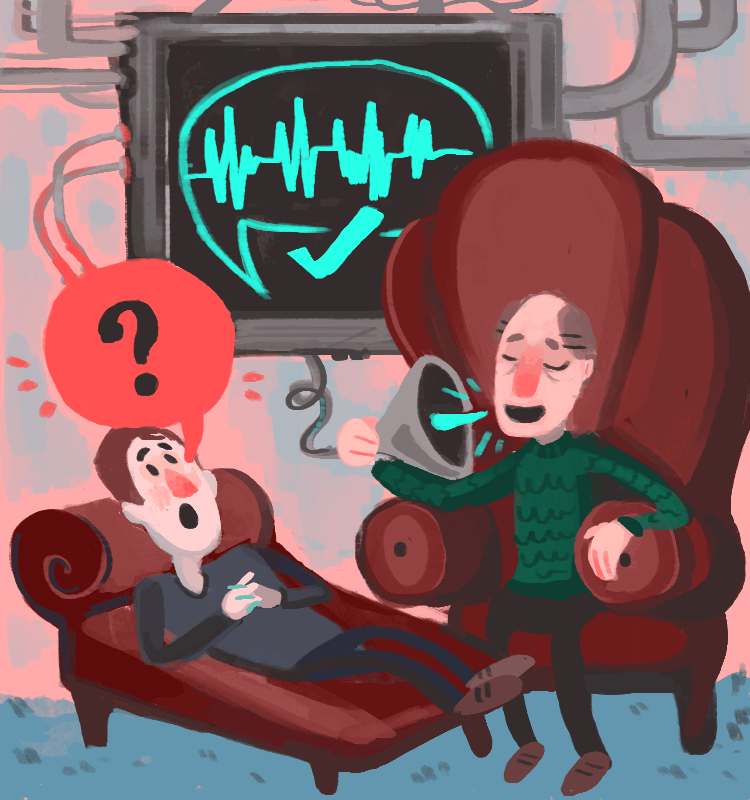Measuring Empathy

“What brings you here today? How are you feeling? What problems are you facing?”
From a couch, the patient answers the questions. Across the room, the therapist takes diligent notes on a clipboard.
According to the American Journal of Psychiatry, approximately 10 million Americans undergo psychotherapy treatment each year, with most experiencing something very similar to the scene described above.
For Professor Shrikanth Narayanan of USC Viterbi’s Ming Hsieh Department of Electrical Engineering, this prompts the question, “How do we know how well psychotherapy works? And what works, and what doesn’t?”
Narayanan is part of an interdisciplinary team developing a new way to evaluate psychotherapy and therapists, relying on the science of signal processing to measure empathic processes. This includes automatically detecting “empathetic opportunities,” as well as characterizing “expressions of empathy.” Eventually, this system could lead to better matches between patients and therapists, and better outcomes.
Signal processing measures and analyzes data, including human-generated data such as speech, language, text and nonverbal behavior. Narayanan’s current research on empathy only evaluates vocal behavior. However, the system may one day analyze visual behavior, such as gestures and facial expressions.
“In our experiment, we have accomplished a prototype system that is able to assess therapist empathy from audio recordings and give quantitative scores of empathy in a human, interpretable way,” said Bo Xiao, a Ph.D. candidate in Electrical Engineering who has worked on the project since 2011.
Although the experiment is in the early stage, a recent test demonstrated that the system is more than 80 percent accurate in its rating ability, Xiao said. The system analyzes audio from therapist sessions, identifying empathetic opportunities hidden within conversations.
“We’re looking at audio, speech and language data. We look at both verbal and nonverbal cues. For instance, laughter is a nonverbal cue that tells you something important about the interaction,” Narayanan said.
An empathetic opportunity is a situation when a patient expresses an emotion, and a doctor has the opportunity to respond empathetically by demonstrating that they understand the patient’s feelings.
Phrases that demonstrate reflective listening, such as “what I hear is,” are considered empathetic. On the other hand, purely instructional phrases like “you need to,” are not deemed empathetic. Additionally, frequent use of high volume and high pitch voice by the therapist is associated with lower empathy.
The research blends psychology with electrical engineering and computer science. Narayanan works closely with Professor Dave Atkins from the University of Washington’s Department of Psychiatry and Behavioral Science. Other key collaborators on this effort include Professor Panos Georgiou and Ph.D. student Dogan Can from USC, and Professor Zac Imel from the University of Utah.
The key difference between Narayanan’s method of psychiatric evaluations and prior ones is objectivity. Typically, therapists are evaluated by someone simply observing them during a session, taking notes on their behavior. However, this approach has limitations, because it is difficult for the human brain to quantitatively measure mechanisms behind something as abstract as empathy.
“[This current method] is limited by human capabilities. Humans are good at certain things, but our perceptual and cognitive abilities aren’t as good, and do not scale well,” Narayanan said.
By automating the evaluation system through signal processing, Narayanan and his colleagues are creating an objective, consistent evaluation process. The new system assigns therapists an empathy level, which evaluators can use to measure a therapist’s overall competence and offer appropriate training. The empathy level ranks therapists based on their responses to empathetic opportunities; the more they recognize such opportunities, and respond empathically, the higher their empathy level.
“This is very human-centered engineering. The role of technology is to support, not to supplant human expertise and intelligence,” Narayanan said.
“Empathetic opportunities” is not a new term within the medical field. Physicians often struggle to identify and respond to empathetic opportunities. A 2008 study suggested that, on average, general physicians miss 90 percent of empathetic opportunities, according to The New York Times.
Narayanan’s automated evaluation system could improve those results by providing therapists with real-time feedback on their responses to empathetic opportunities. In this way, Narayanan hopes the technology will help psychiatrists adjust to their patient’s individual needs.
“Different physicians have different expertise, and they apply this expertise differently. The therapist–patient fit is important, and recognizing empathetic opportunities and responding appropriately is an important part of this,” Narayanan said.
Narayanan likens therapist evaluations to drug trials: We test the efficacy of drugs, to understand what works, when and for whom. So, it makes sense to evaluate objectively the efficacy of therapists. Such evaluations can improve psychotherapy, as well as the therapist–patient fit.
“If you want truly personalized health care, it’s not just in pharmaceutical care but also in psychological care,” Narayanan said.



